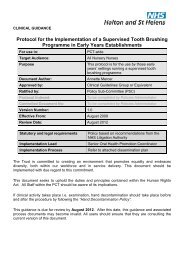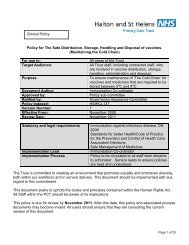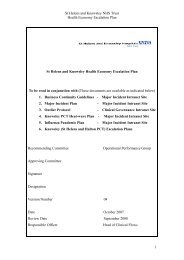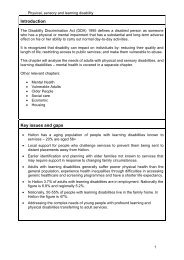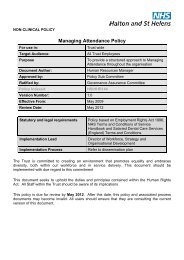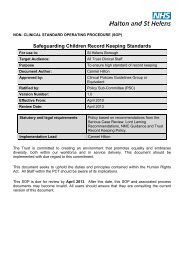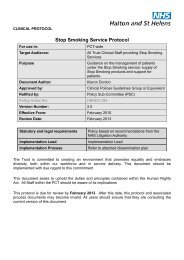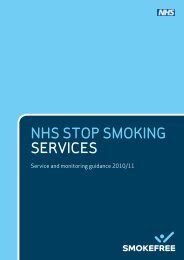Collaborative Intravenous Nursing Service (CINS) Guidelines
Collaborative Intravenous Nursing Service (CINS) Guidelines
Collaborative Intravenous Nursing Service (CINS) Guidelines
- No tags were found...
Create successful ePaper yourself
Turn your PDF publications into a flip-book with our unique Google optimized e-Paper software.
experience. Due to the volume of the above studies the authors of this policy decided to useonly reviews as evidence. The authors also reviewed other policies from the UK andcontacted the manufacturer of each drug asking for their recommendations for the treatmentof an extravasation with that particular drug.As a result most of the recommendations contained in this policy will be Grade B or C andwill be a result of evidence obtained from reviews, other UK extravasation policies, andmanufacturers.18Treatment RecommendationsEvidenceA. Apply cold pack, firmly but withoutpressure, intermittently for 30 minutesin very 2 hours over the area for thefirst 24 hours, unless advisedotherwise. The cold pack should not beplaced directly on the skin. Place apiece of dry gauze between the skinand the cold pack.Application of cold to the site is thought todecrease toxicity of the agent to the area. It isbelieved this causes vasoconstriction, localisingthe extravasation and perhaps allowing time forlocal vascular and lymphatic systems todisperse the agent as well as shunting bloodaway from the area and reducing cellularmetabolism i,ii,iii,iv . The application of cold tovinca-alkaloid induced injuries has been shownto increase ulcer formation in animal studiesand therefore the use of cold should bereserved only for the treatment of non vincaalkaloidvesicant injuries i,ii,iii,ivIntermittent local cooling for up to 24 hoursappears to be the recommended schedule ii .The evidence supporting this treatmentconsists entirely of III or IV reports but issufficiently extensive that this can berecommended at Grade B.B. Apply topical hydrocortisone 1% creamevery six hours for the next 7 days orfor as long as erythema continues.Many guidelines recommend the use ofsubcutaneous or intradermal steroids. Howevermany of the reviews found argued thatinflammation is not prominent in the aetiologyof tissue necrosis i,ii,iii,iv,v . There is also evidencethat subcutaneous or intradermal steroids maybe harmful in high doses i,ii , are ineffective incertain extravasations ii and may increase theskin toxicity of vinca alkaloids i,ii . Therefore thisguideline recommends that topicalhydrocortisone 1% is used, which can do littleharm and may bring down non-specificinflammation, except in vinca-alkaloid injuries.The evidence supporting this treatmentconsists entirely of III or IV reports but issufficiently extensive that this can berecommended at Grade B.The CINs group hereby assert their moral rights tothe works herein in accordance with the Data Protection Act 1988.Policy review date 01/10/10




